 |
|

|
 |
TABLE of CONTENTS
 |
Promotional campaigns target pedestrians, drivers to boost safety |
By Kristin Kammueller

A billboard on Snelling Avenue in St. Paul displays one of the pedestrian safety messages that is part of the work zone and pedestrian safety campaign throughout the state during the construction season. Photo by Rich Kemp |
The Office of Traffic Safety and Technology will spend $1.65 million in federal funding during the next year to raise public awareness and improve work zone and pedestrian safety.
“Safety is everyone’s responsibility. This is money well-spent if we can prevent even one death or serious injury in our work zones or crosswalks,” said Peter Buchen, Assistant State Traffic Engineer.
The work zone safety campaign kicked-off June 9 in District 6 and District 7 and will continue around the state through the construction season.
Motorists driving across Minnesota will see the “Orange Cones, No Phones” message on billboards and gas pump toppers as a reminder to hang up their phone and pay attention to keep workers—and themselves—safe.
Radio ads also will be played throughout the state to reach a larger audience. Listen to the work zone safety radio ad Tis the season (MPEG-4).
The work zone safety campaign is part of the Minnesota Toward Zero Deaths effort, a multi-agency partnership that uses education, enforcement, engineering and emergency trauma response to promote safe and smart driving behavior. The Minnesota TZD partners include the departments of Health, Transportation and Public Safety. Since its launch 10 years ago, the TZD effort has helped decrease roadway fatalities by nearly half, from 655 in 2003 to 387 in 2013.
“Drivers face many distractions under the best of conditions, and driving through construction work zones only increases these distractions,” said Kristine Hernandez, statewide TZD coordinator. “We hope this campaign helps raise awareness and makes people think twice before picking up their phone in a work zone.”
The pedestrian safety campaign is focused on University and Snelling avenues in St. Paul to coincide with the launch of the light rail transit line between St. Paul and Minneapolis. One of the new Green Line trains has been wrapped with two different pedestrian safety messages, one geared toward pedestrians and the other targeted to drivers.
The safety messages, some translated into Spanish, Hmong and Somali, include “Stop for Pedestrians at Every Corner” and “Distracted Walking is Dangerous Walking.”
In addition to the train wrap, there are pedestrian safety posters at three of the Green Line train stops and five pedestrian messages within the wrapped train.
Three billboards near Macalester College, as well as five of the transit stations along Snelling Avenue, display pedestrian safety messages. The 65 Metro Transit buses that travel along Snelling Avenue also have the pedestrian safety messages on the side.
For more tips for staying safe in highway work zones, see www.mndot.gov/workzone/. For more information about pedestrian safety, see www.mndot.gov/sharetheroad/ped. |
 |
|

|
 |
TABLE of CONTENTS
 |
Hwy 29 project in Alexandria illustrates efficiencies of state, city, business partnerships |
By Jerimiah Moerke, District 4 public affairs coordinator

The Hwy 29 construction project through Alexandria comes with a complete re-build of the underground facilities and a Complete Streets redesign. Photo courtesy of the Voice of Alexandria/Alex Road Report |
By the end of the construction season, five blocks of Broadway Street, which also serves as Hwy 29, will be completely new from storefront to storefront, both above and below ground.
The project is the result of a partnership between the city and MnDOT District 4.
In 2010, the district began planning for a basic mill and overlay with ADA improvements and signal upgrades to improve mobility. At the same time, the community began discussing ways to better incorporate walkers and bicyclists through downtown using the Complete Streets concept.
“The stars aligned for this project,” said Jody Martinson, District 4 engineer. “MnDOT could not do this project alone; the city and its utilities could not do this alone. But working together, we were able to leverage funds, maximize efficiencies and develop an exciting project for downtown Alexandria.”
The city jumped at the opportunity to team up with MnDOT on a much larger, total reconstruction project. Not only will it give the community’s Main Street a facelift, but it will also give underground utilities a much-needed upgrade. The old underground infrastructure was about 75 years old and averaged about one water main break per year, according to Tim Schoonhoven, city engineer.
“It was a Band-Aid on a Band-Aid,” said Schoonhoven.
For the past four years, Alexandria, in conjunction with engineering firm Widseth-Smith-Nolting, has taken the lead on the project, working closely with community leaders, businesses, residents and MnDOT. The state was actively involved in the review process to ensure the designs followed all policies and design standards.
The project itself began on the north end of Broadway on May 12. It is being completed in three phases to reduce the impacts on adjacent businesses. The first and third phases will each last approximately two months. The second phase will take about one month. Detours, signage and pedestrian access routes will all be adjusted as the project proceeds.
The downtown Alexandria business district is primarily tourist-driven, made up of antique shops, boutiques and small restaurants. As with any project, many owners are concerned about the impact construction will have on their livelihood, especially since construction coincides with the city’s busy season. A committee of representatives from downtown businesses, the city and other agencies developed a communications and marketing plan to help mitigate some of those concerns.
The Redesigning of Alexandria’s Downtown Committee has met monthly for more than a year. ROAD raised more than $32,000 through grants, donations from community organizations and in-kind contributions from local media outlets. That money is supporting downtown businesses largely through internet, radio and print ads and large banners on display downtown. The committee also coordinates a website with twice-weekly project updates, a weekly newspaper column by the mayor, The Buzz on Broadway, and a live web cam.
Key elements of the project:
- Concrete road surface
- Traffic signals
- Wider, more accessible sidewalks
- Landscape amenities such as trees and plants, bike racks and benches
- Underground water line replacement
- Underground storm sewer and sanitary sewer system replacements
Sellin Brothers, Inc., of Hawley is the prime contractor on the project, which will be completed in October and will cost $5.7 million, approximately half of which will be funded by MnDOT.
Check out the project website for more information. |
 |
|

|
 |
TABLE of CONTENTS
 |
Driving change: MnDOT’s Online Customer Community provides input, impact |
|
By Stephany Osuji, Office of Customer Relations
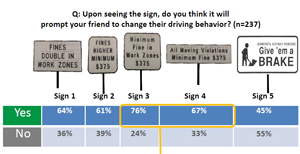
The chart above shows how a sample of MnDOT’s online community responded to the question, “Upon seeing the sign, do you think it will prompt your friend to change their driving behavior?” |
Ever have a concept or idea you wanted to “test run” before moving forward? Or wished you had a customer advisory group to use as a sounding board to make important decisions? MnDOT’s Online Customer Community may be the answer.
The online community, managed by the Office of Customer Relations, is a market research panel composed of 450 Minnesotans randomly selected to demographically reflect Minnesota’s general population - geographic location metro vs. greater Minnesota, gender, age, income, etc. MnDOT connects with the panel of customers every week on a variety of transportation topics. They anticipate surveys and discussion topics every Thursday and respond with prompt, candid and in-depth feedback. Half of the customers are from the Twin Cities area and half are from Greater Minnesota.
One bill presented and passed during the last legislative session about work zone safety was the result of feedback from the online community.
Earlier this year the Office of Traffic, Safety and Technology called on community members to weigh in on the potential bills and signage related to work zone safety. Community members strongly felt that work zone signs with the message, Fines double in work zones wasn’t enough to deter drivers from speeding or changing their driving behavior. Conversely, when members previewed proposed signage that posted the dollar amount of the fine, the message had more resonance with respondents, who acknowledged that if they saw the sign with the fine specified, they were more likely to slow down in work zones.
Also, more than half of the online community said that the proposed $300 fine in work zones was the correct amount to charge for the offense. Overall, the majority of surveyed members were in support of increasing safety measures within work zones.
“The online community gives us legitimate, real-time, informed feedback on many levels and we’re using it again now as we consider improvements on detour signing,” said Tom O’Keefe, Metro District Program Delivery director.
Now in its fourth year, many transportation topics have been covered, including 511, Share the Road, financial responsibility and construction impacts. For a list of past topics, go to the online customer community webpage.
Feedback from the online community also helped MnDOT gain a better understanding of public expectations when it came to demonstrating financial effectiveness. The findings from the study assisted in developing content for materials around MnDOT’s Wildly Important Goal battle of Information and Outreach.
In her recent announcement of MnDOT’s new Enhancing Financial Effectiveness Get Connected external website, Deputy Commissioner Tracy Hatch noted, “For content, we leaned heavily on our online customer community to identify and respond to their common questions, such as: Where does the money come from? Where does the money go? What are the agency’s goals? What progress are your making toward these goals? and How are your projects selected?”
The Get Connected website was tested with the online community again, once the content was created, and additional changes were made that reflected interest and usability of the site.
For more information on how to use the online community, contact Stephany Osuji, at 651-366-3179 or stephany.osuji@state.mn.us |
 |
|

|
 |
TABLE of CONTENTS
 |
St. Croix Crossing boat tours to reach 2,600 people during 2014 construction season |
By Jessica Wiens

Work on four of the five river piers for the St. Croix Crossing is under way. This photo is taken from the pier closest to the Minnesota shoreline, looking east towards Wisconsin. This year, crews will construct all piers to the height of the bridge deck and cast segments that eventually will become the driving surface for the bridge. Photo by Elia Ayaz |
The St. Croix Crossing bridge project team is spending one Saturday and one Wednesday per month through September hosting public boat tours of bridge construction on the St. Croix River near Stillwater.
The first tour was Saturday, May 31, with about 210 people in attendance. Both media and word-of-mouth attention created buzz for the additional eight tours. All tours are now full with approximately 300 people registered for each tour.
“We know the public is interested in watching construction unfold, but safe, public access points to view it close-up from shore simply don’t exist,” said Jon Chiglo, project director. “This is an opportunity for the public to ask questions directly to engineers and learn what it takes to efficiently and effectively build this project.”
Through these site visits, area residents and St. Croix Valley visitors can see bridge construction as close as 300 feet away while on a paddleboat.
During the tours, staff from the Minnesota and Wisconsin departments of transportation present information and answer questions. This includes progress to date and work occurring on the bridge, Minnesota approach on Hwy 36/95 and Wisconsin approach on WIS 35/64.
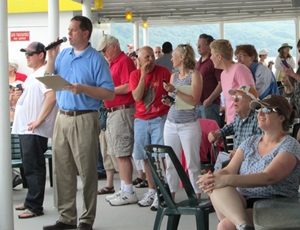
St. Croix Crossing Project Director Jon Chiglo (blue shirt) explains work occurring on the St. Croix Crossing bridge piers at the Saturday, May 31, public boat tour. Photo by Jessica Wiens |
To make this opportunity possible, the project team approached the St. Croix Boat & Packet Company with the idea.
“Based on the success of the first tour and the level of public interest, we plan to continue these tours throughout bridge construction in 2015 and 2016,” said Chiglo.
The project team is currently brainstorming additional ways to get project information shared during the boat tours to a broader public audience, while still ensuring the project gets built on time and on budget.
The new river crossing is scheduled to open in fall 2016.
People who did not register for a tour in 2014 can still receive updates and information about the project in the following ways:
|
 |
|

|
 |
TABLE of CONTENTS
 |
Toward Zero Deaths workshop focuses on ways to achieve safer roadways |
|
By Mary McFarland Brooks
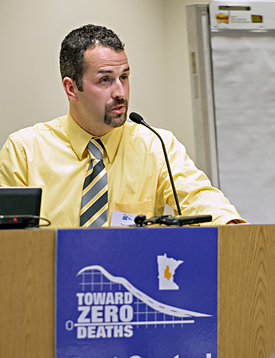
Tom Nixon, Central Minnesota TZD regional coordinator, helped coordinate the East Central Minnesota Toward Zero Deaths Workshop in St. Cloud June 3. Photo by David Gonzalez |
More than 65 participants from cities, counties, townships, state agencies and law enforcement offices in the region attended the east central TZD workshop June 3 in St. Cloud where presenters described methods of achieving safer roadways and better educating motorists.
The goals of the east central TZD effort are to:
- Encourage traffic safety as a priority for policymakers
-
Provide a method to bring traffic safety programs into the community
-
Spread successes of the East Central Minnesota Toward Zero Deaths program
-
Network with other traffic safety advocates
The St. Cloud agenda included recent statewide trauma system data and information about how emergency services have had a positive effect on fatality rates for motor crash victims. Other agenda items included:
- A presentation on rumble and mumble strips, roundabouts and J-turns and their impacts on vehicle crashes
- The father of a young woman who died in a distracted driving crash, who spoke about his family’s loss and the impact on his daughter’s high school community
- Several Minnesota State Patrol officers who shared effective efforts in regard to distracted driving
- Katie Fleming, research analyst at MnDOT’s Waters Edge facility, who discussed the State Highway Safety Plan stakeholder results with the group
After the presentations, the participants broke into groups to discuss how effective countermeasures to the main causes of crashes, employed locally, can have positive results. The breakout sessions stressed the 4 e’s of TZD: education, enforcement, emergency services and engineering.
“I was very pleased with attendance and participation at the St. Cloud TZD workshop,” said Tom Nixon, Central Minnesota TZD regional coordinator. “Many people are responsible for making the workshop successful; it is rewarding to see so many projects moving forward.”
Working together, the departments of Public Safety, Health and Transportation are confident that the 2014 TZD goal of 350 fatalities, (compared to 387 fatalities in 2013 and 568 fatalities in 1990) can be achieved. The workshop sponsors included the DPS, MnDOT District 3 and East Central Minnesota TZD program.
About Minnesota TZD...
The Minnesota Toward Zero Deaths program is in its 11th year of identifying issues contributing to fatal road crashes and finding solutions for safer roadways in Minnesota.Since the 1990s, the Minnesota Department of Public Safety and MnDOT have been working together to find better solutions to the problem of serious injuries and fatal crashes on Minnesota roadways.
In 2001, the North Star Workshop brought together experts from many Minnesota research organizations and state agencies — as well as presenters from Washington, Sweden (where the “zero-deaths” concept was first adopted), and Australia — to share information. The TZD program developed out of the momentum created by the North Star workshop. TZD workshops are held throughout the state to educate and train participants and share results of the State Highway Safety Plan and current research regarding motorists’ behaviors. |
|
 |
|

|
 |
TABLE of CONTENTS
 |
What’s the life of a road sign? |
By Shannon Fiecke, Research Services & Library
Video covers a research project on highway sign life expectancy. Video courtesy of Research Services. |
Traffic signs provide important information to drivers, and are a critical component of traffic safety. In order to be effective, their visibility and readability must be maintained under both day and night conditions.
Key to signs’ effectiveness is a quality known as retroreflectivity — the ability for signs to bounce light back toward a driver’s eyes, making them appear brighter and easier to read. Retroreflectivity deteriorates with time, so transportation agencies need to actively maintain their signs.
A research project funded by the Local Road Research Board is developing a guide to help cities and counties better manage their signs, and also to meet a new Federal Highway Administration retroreflectivity management requirement while getting the lowest life-cycle costs.
Cities and counties had until June to establish a sign assessment or management method that would maintain minimum levels of sign retroreflectivity.
“Right now there’s a mixture of different management methods, with very little guidance as to what’s appropriate for your agency based on the signs, equipment and labor force you have,” said Matt Lebens, MnDOT research project engineer.
Since 1993, the Manual on Uniform Traffic Control Devices has included guidelines for minimum retroreflectivity of pavement markings and signs. The standards are meant to ensure that drivers, especially the growing population of elderly drivers, are able to detect, comprehend and react to traffic signs. The LRRB project is designed to help fill certain knowledge gaps in this area.
Measuring retroreflectivity
Possible methods for ensuring retroflectivity include night-time inspection, use of a reflectometer, spot-checking a sampling of signs that are the same age, or blanket replacement of signs once they reach a certain age.
Although the retroreflectivity of a sign is guaranteed by its manufacturer to last a certain number of years, it commonly lasts much longer.
“Currently, we don’t have expected sign life guidance for agencies to use. Through this project, we are establishing a control deck for sign sheeting used in the state, and an expert panel will make recommendations on expected sign life ranges,” Lebens said.
Researchers reviewed retroreflectivity studies from other states and also measured the retro-reflectivity of signs out in the field across Minnesota using a retroreflectometer. As part of this project, MnDOT provides training on the retroreflectometer and makes it available for loan to local municipalities. (Watch a video demonstration.)
At the MnROAD site, control decks contain dozens of signs. In addition to measuring retroreflectivity, the MnDOT Materials lab is monitoring color fade, which has been a larger issue in Minnesota.
“By getting better data as to the real-life, in-field life span of the signs, agencies will have a more realistic and better informed value for sign life expectancy, as well as potentially reducing costs,” said Mark Vizecky, senior engineer.
|
 |
|

|
 |
TABLE of CONTENTS
 |
Metro District receives Governor’s Safety Award |
By Libby Schultz
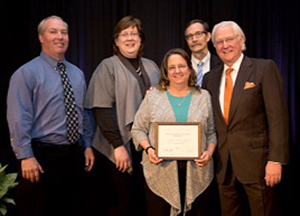
From left, Doug Thies, Metro District safety administrator, Bev Farraher, Metro District maintenance engineer and Julie Libonate, Metro District safety services supervisor, receive a Meritorious Achievement Award from Robert Lund, Minnesota Safety Council president and former WCCO news anchor Don Shelby at the Governor’s Safety Awards Luncheon May 8. Photo by David Gonzalez |
The Metro District received the Meritorious Achievement Award in Occupational Safety on May 8 at the Governor’s Safety Awards Luncheon.
To apply for the award, each organization must submit all loss data, which is compared to the data from similar organizations. The data has to show a reduction in the number of workplace accidents and loss days for three consecutive years to receive the Meritorious Achievement Award.
“What’s caused the reduction is the districtwide emphasis on safety and working safely every day,” said Doug Thies, District safety administrator. “The award is a true testament to employees making good decisions when they’re working and helping their fellow workers by pointing out safety conditions and concerns."
|
 |
|

|
 |
TABLE of CONTENTS
 |
Growing professionally through leadership development |
By Lisa Yang
Whether you’re a maintenance worker, engineer or planner, the Leadership Development Program offers opportunities to learn more about the different parts of MnDOT, and most importantly, trainings and workshops that help you grow professionally and personally.
The LDP has an upcoming enrollment period that starts June 23 and closes July 21. All employees are encouraged to find out more about the program by going to http://ihub/leadership/. Employees who can’t participate this time around can look forward to the next registration opportunity in February 2015.
Participants will be in the program for 11 months and have access to new and existing learning opportunities that will assist them in meeting their goals in the program.
More than 230 employees have participated in the LDP and some have participated more than once. Cynthia Yost, District 1 accounting technician, Mindy Heinkel, Metro smooth pavement coordinator, and Robert Jones, District 7 graduate engineer, participated in 2013-14 and shared their experiences with Newsline.
Cynthia Yost – District 1 (Duluth) accounting technician

As part of the Leadership Development Program, Cynthia Yost, District 1 accounting technician, checked out the Snow Plow Operators Training at Camp Ripley in October. Photo courtesy of District 1. |
I started my career with MnDOT in 2006 in District 3 as a customer service specialist and then moved to District 1 Duluth in December 2011 for a promotion to be an accounting technician. I heard about the program from Jessica Leslie in Human Resources. She attended the session prior to me and felt it was a great learning experience. Based on Jessica’s recommendation, I decided to get my supervisor’s approval to sign up and participate in the program. I thought that by participating, I could leverage the program to get a better understanding of the many facets of MnDOT and learn about what other areas of the business do and at the same time, broaden my overall knowledge.
Some of the experiences that I thought were most valuable was visiting Camp Ripley and seeing the Snow Plow Operators Training first hand. Seeing the trucks up close and learning about the courses the drivers have to learn was an eye-opener. Just being able to operate a snow plow with all those buttons is simply amazing! The most beneficial part of the program that I attended was the Dynamics of Communication and learning about the different way people communicate, how emotions play on communication styles and decision making.
I would strongly encourage other employees to participate in the Leadership Development Program. The program is an excellent opportunity to learn about all different aspects of MnDOT and how each piece fits together like a big complicated puzzle.
Mindy Heinkel – Metro District smooth pavement coordinator
In June 2011, I started as a laborer for MnDOT in Surveys. I was hired full-time in September 2011 as a transportation generalist in Metro Maintenance and then accepted my current position as a state program admin technical specialist in December 2012 as the smooth pavement coordinator for Metro District.

At right, Mindy Heinkel, Metro District smooth pavement coordinator, networks with other Leadership Development Program participants at a Managing Minnesota Bridges learning opportunity on May 21. Photo by Shawn Meade |
I first learned of the Leadership Development Program from a co-worker. I decided to participate in LDP because I’m still fairly new to the agency. I felt that LDP would provide me with a wide range of insight to all levels of the agency. Through this program, I gained knowledge in a variety of aspects such as identifying basic concepts in bridge engineering and design, increased knowledge of state and federal legislative process, MnDOT’s new organizational structure, and our strategic priorities. LDP also provided me the opportunity to enhance my communication, leadership, presentation and coaching skills.
I would encourage any new or seasoned employee to participate in LDP. The program offers many opportunities to pick and choose trainings that will work for you and your schedule. I plan on participating in the future as different opportunities arise and to attend the training or classes that I wasn’t able to participate in. The best part for me was the positive learning environment and networking with others.
Robert E. Jones – District 7 graduate engineer
I became part of the MnDOT family in 2012 as a graduate engineer. After spending 19 years in federal government, it has been rewarding to come full circle back to my engineering roots at MnDOT. I have truly enjoyed my two years in the Graduate Engineer and Land Surveyor Program—especially the opportunity it has given me to learn the multi-faceted world of MnDOT as well as participate in the Leadership Development Program to better sharpen my managerial and leadership skills as I transition into a project manager role in D7.
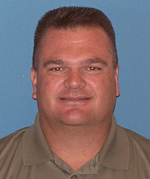
Robert E. Jones, District 7 graduate engineer, took the Inside-Out Coaching and Life Orientation training as part of the Leadership Development Program. Photo courtesy of District 7 |
When I heard about the LDP through my district training coordinator, I knew I had to experience this level of training MnDOT had to offer. I saw the opportunity to network with other districts and specialty groups within MnDOT. I focused my development on personal leadership growth by attending the Inside-Out Coaching and Life Orientation or LIFO training. Both these courses helped me focus my efforts on becoming a better leader and inspiring those that work around me—I also used these techniques in my personal time as a basketball and softball coach for my kids.
The LDP has provided me with excellent opportunities for career and educational development. It was a great experience for me, contributing to my growth both socially and professionally—I would recommend the program to any of my MnDOT family members.
|
 |
|
| |
|



